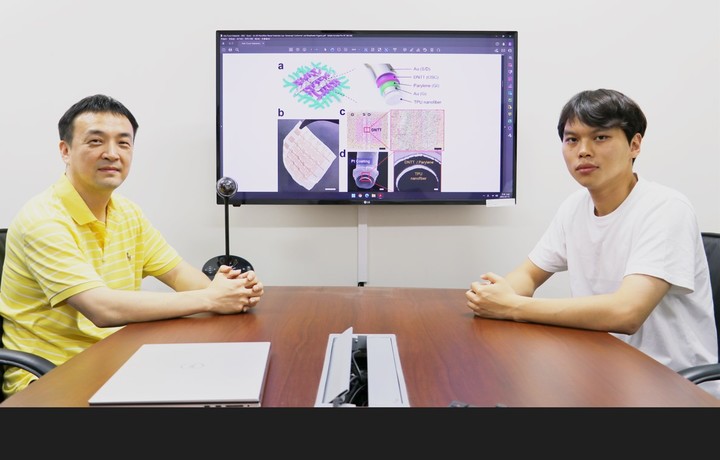News & Event
- Home
- News
- News & Event

Professor Seongwon Lee (left) of the Department of Chemical Physics and Ph.D. student Hyukju Choi)
According to Newsis,
A research team at DGIST developed the world's first electronic skin device with a mesh structure.
DGIST (Daegu Gyeongbuk Institute of Science and Technology) Department of Chemical Physics Professor Seongwon Lee's research team developed an Organic Field-Effect Transistor (OFET) with a very thin thicknessand excellent air permeability that can be used as an electronic skin device. The team announced on the 4th that the OFETs was successfully developed for the first time in the world.
OFETs with nanomesh structures are expected to be able to extract physiological data directly from the skin and optimize information processing through integration with various sensors.
Electronic skin is an electronic device attached to the skin, which measures signals such as body temperature, heart rate, electromyography, and blood pressure, and transmits these data.
Recently, as interest in smart health care systems using wearable devices has increased, the development of related technologies has been activated. In order to accurately measure biosignals through health care systems in real time, flexible sensors are required because most tissue surfaces are smooth and in constant motion. come.However, if a sensor having a flat substrate structure with low liquid or gas permeability is attached to the skin surface for a long period of time, unexpected diseases such as atopy or metabolic disorders may occur.Therefore, electronic devices that come in direct contact with the surface of a living body must be breathable in order to function for a long time.
Therefore, research on a device of a polymer nanofiber-based nanomesh structure having excellent air permeability is attracting a lot of attention.
Accordingly, Professor Seongwon Lee's team at DGIST developed an ultra-thin nanomesh structure OFET that can be combined with various sensors without causing discomfort to the wearer.
OFET devices showed consistent performance even when folded or curved surfaces, and showed stable switch characteristics with little performance degradation even in harsh environments such as over 1000 deformations or high humidity.
The reason that it was difficult to implement the transistor with the existing nanomesh structure was that the surface was rough and the properties of nanofibers lacked mechanical robustness, thermal and chemical stability.
Professor Seongwon Lee's team was able to solve this problem at the same time by using a material called Parylene C, which is suitable as a biocompatible coating.In addition, by using the vacuum deposition method that was used previously, the process was made simpler than the synthesis or high-temperature process.
Professor Lee Seong-won said, “We succeeded in developing an organic field-effect transistor with a nano-mesh structure for the first time.Furthermore, we have successfully demonstrated an active matrix integrated tactile sensor with a sensor attached.” “Development of a transistor was essential for realizing a complex circuit. I will be able to do it.”
This research was published in 'Advanced Functional Materials', a well-known international academic journal in the field of Nanoscience & Nanotechnology.
Copyrights Newsis. All Rights Reserved.
Reprint of redistribution without permission is prohibited
Source: Newsis (August, 4, 2022)
** This article was translated from the Korean.